Which Of The Life Cycles Is (Are) Typical For Animals?
In biology, life wheel is the series of changes that an organism undergoes from its inception by means of reproduction, whether through asexual reproduction or sexual reproduction, to the inception of the following generation in that same phase of the cycle.
For some organisms, especially small, uncomplicated organisms such as bacteria and some protists, the life cycle is complete in one generation. This is too the case for many animals, where the male person and female person gamete fuse to course the new offspring. In plants, reproduction is multi-generational, also known every bit alternation of generations.
While life cycle types can be placed into a few wide categories (haplontic, diplontic, etc.), the specific life cycles of individual species bear witness great diversity, such as the timing of the onset of various stages, methods of fertilization, and then forth. Diverseness among living organisms is a basic biological principle and an important component in the joy humans experience from nature. Of class, organisms in closely-related species and taxa share similar life cycles. The near ubiquitous presence of sexual reproduction, combined with genetic recombination, promotes uniqueness among individuals as well.
Contents
- 1 Sexual reproduction life cycles
- 1.ane Diplontic life cycle
- i.2 Haplontic life wheel
- i.iii Diplobiontic life cycle
- 2 Asexual reproduction life bike
- 2.1 Binary fission
- iii Alternation of generations
- 3.ane Distinctions
- three.2 Fungi
- 3.3 Protists
- iii.4 Plants
- 3.iv.i Not-vascular plants
- three.4.2 Vascular plants
- four Mammal reproduction and early on life bike
- 5 Life history theory
- 6 References
- vii Credits
Sexual reproduction life cycles
Three types of life cycles be, depending on ploidy, a multiple of the number of chromosomes in a cell:
- haplontic life cycle
- diplontic life bike
- diplobiontic life cycle (besides referred to equally diplohaplontic, haplodiplontic, or dibiontic life cycle)
These three types of cycles feature alternating haploid (northward) and diploid (2n) phases.
The haploid organism becomes diploid through fertilization, with joining of gametes. This results in a diploid zygote. To return to a haploid stage, meiosis must occur.
The cycles differ in the product of meiosis, and whether mitosis (growth) occurs. Zygotic and gametic meiosis take one mitotic stage and form during the n phase in zygotic meiosis and during the 2n stage in gametic meiosis. Therefore, zygotic and gametic meiosis are collectively term haplobiontic (unmarried meiosis per phase). Sporic meiosis, on the other hand, has ii meiosis events (diplobiontic): 1 in each phase.
Diplontic life cycle
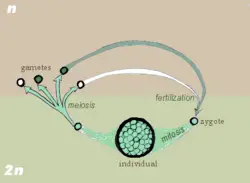
In gametic meiosis, the diploid zygote undergoes mitosis to produce a multicellular diploid individual or a group of more diploid cells. Cells from the diploid individuals then undergo meiosis to produce haploid gametes.
The haploid gametes practice not undergo mitosis, and practice not grow into a larger haploid organism. Rather, the haploid gametes fuse and produce the diploid zygote with gametes of the opposite blazon.
In the whole bike, gametes are the only haploid cells; mitosis occurs but in the diploid phase.
The diploid multicellular private is a diplont, hence a gametic meiosis is also called a diplontic life cycle. Diplonts include:
- Animals
- Some dark-brown algae
Haplontic life cycle
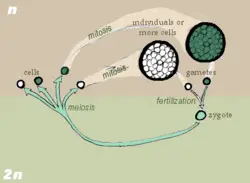
A zygotic meiosis is a meiosis of a diploid zygote immediately after karyogamy, the fusion of two cell nuclei. In this way, the organism ends its diploid phase and produces several haploid cells. These cells undergo mitosis (split mitotically) to class either larger, multicellular individuals, or more haploid cells. Two opposite types of gametes (e.g., male and female) from these individuals or cells fuse to become a diploid zygote.
In the whole bike, zygotes are the simply diploid cell; mitosis occurs only in the haploid stage.
The individuals or cells as a result of mitosis are haplonts, hence this life bicycle is too called haplontic life bicycle. Haplonts are:
- All fungi
- Some green algae
- Many protozoa
Diplobiontic life cycle
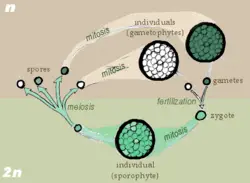
Alternation of generations
In sporic meiosis, likewise known as intermediary meiosis, mitoses occur in both the diploid and haploid phases. The organism exhibits alternation of generations, which features spore-producing multicellular sporophytes (which are diploid) and gamete-producing multicellular gametophytes (which are haploid). Diagramatically, sporic meiosis looks like the complex halves of gametic meiosis and zygotic meiosis are merged into one.
This type of cycle is diplobiontic (also known every bit diplohaplontic, haplodiplontic, or dibiontic).
Sporic meiosis occurs in plants and many algae. Having multicellular individuals in both phases means that for some seaweeds, it is difficult to make up one's mind if a macroscopic specimen is gametophytic or sporophytic unless observed under a microscope, this is called isogamy. Still, non all species with sporic meiosis have both large gametophyte and sporophyte generations. The trend in college plants is having smaller gametophytes that are more dependent and parasitic on sporophytes, a phenomena known as heterogamy.
Asexual reproduction life cycle
In cases of asexual reproduction, the life cycle is complete in one generation, where an individual inherits all of its chromosomes from one parent and is genetically identical to its parents. Prokaryotes, such equally bacteria, undergo binary fission, where each cell divides in half to form two cells with identical DNA to the original cell. In order for the original cell to split, the prokaryotic chromosome that is a unmarried DNA molecule must get-go replicate and so attach itself to a different part of the jail cell membrane. Virtually protists, unicellular eukaryotes, also reproduce asexually, except under stress they reproduce sexually.
Binary fission
Binary fission is the form of asexual reproduction used by nearly prokaryotes to reproduce. This process results in the reproduction of a living prison cell by division into two equal or near-equal parts.
Binary fission begins when the Dna replication occurs. Each round Deoxyribonucleic acid strand and so attaches to the prison cell membrane. The cell elongates, causing the two chromosomes to separate. The cell membrane then invaginates (grows in) and splits the jail cell into two daughter cells through a process called cytokinesis.
Organisms that reproduce through binary fission mostly grow exponentially.
This type of asexual reproduction usually results in two identical cells. However, bacterial Dna has a relatively high mutation rate. This rapid charge per unit of genetic change is what makes bacteria capable of developing resistance to antibiotics and helps them exploit invasion into a broad range of environments.
Diverse single-celled eukaryotes besides reproduce by the splitting of the original cell into two cells, although this involves mitosis and cytokinesis similar to the cells of a multicellular eukaryote organisms. While historically these eukaryote single-prison cell divisions have been referred to in the literature as binary fission, this term today is often reserved for prokaryote reproduction, which does not involve mitosis since they lack a membrane-bounded nucleus. Amidst eukaryotes that reproduce past the splitting of the original prison cell into two are
- Virtually protists (for case, Amoeba proteus)
- Entamoeba histolytica (a protozoan that is a human intestinal parasite)
- Pyrodictium abyssi (an anaerobic hyperthermophilic archaea of deep-sea hydrothermal vents)
- Schizosaccharomyces pombe (a fungal organism that is a species of yeast)
In improver, the mitochondria and chloroplasts of eukaryote cells besides split up past binary fission.
Many multicellular organisms also have the ability to reproduce asexually. Many such organisms will bud off a localized cluster of cells, which and then grows through mitosis to form a new individual. Animals such as sponges tin can reproduce by fragmenting their bodies. Many plants accept the ability to reproduce asexually as well.
Alternation of generations
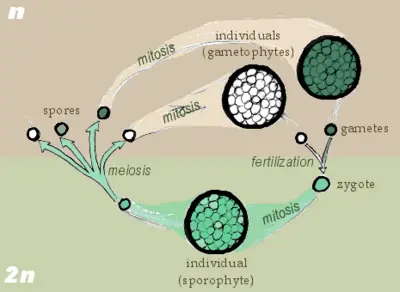
Sporic or diplohaplontic life cycle. A diploid (2n) sporophyte undergoes meiosis to produce haploid (1n) reproductive cells, oft called spores. Haploid cells undergo mitosis to produce a gametophyte. The gametophyte produces haploid gametes which fuse to form a diploid zygotic sporophyte.
Alternation of generations is a term applied to a reproductive cycle (a diplobiontic life cycle) of sure vascular plants, fungi, and protists. The term is a scrap confusing for people familiar only with the life bike of a typical animal. A more understandable proper name would be "alternation of phases of a unmarried generation" because we normally consider a generation of a species to cover one complete life bike. The life cycle of organisms with "alternation of generations" is characterized by each phase consisting of one of 2 separate, free-living organisms: a gametophyte (thallus or found), which is genetically haploid, and a sporophyte (thallus or establish), which is genetically diploid.
A haploid plant of the gametophyte generation produces gametes past mitosis. Two gametes (originating from unlike organisms of the same species or from the same organism) combine to produce a zygote, which develops into a diploid plant of the sporophyte generation. This sporophyte produces spores by meiosis, which germinate and develop into a gametophyte of the adjacent generation. This wheel, from gametophyte to gametophyte, is the style in which plants and many algae undergo sexual reproduction.
Distinctions

The underside of a Dicksonia Antarctica frond showing the sori, or spore-property structures.
The distinction of "free-living" is important, because all sexually reproducing organisms can be thought to involve alternating phases, at least at the cellular level as meiosis. All the same, not all biologists agree. Information technology is often stated that alternation of generations refers to both the diploid and haploid stages being "multicellular" and this is more important than "gratis-living" (Taylor T.Due north. et al. 2005). Such a stardom changes the concept to one separating animals and plants.
All plants have diploid sporophyte and haploid gametophyte stages that are multicellular, and the differences between plant groups are in the relative sizes, forms, and trophic abilities of the gametophyte or sporophyte forms, as well as the level of differentiation in the gametophytes. An example would exist comparison pollen and ovules to bisexual gametophyte thalli.
Biologists recognize two categories of alternation: the starting time if the sporophyte and the gametophyte forms are more or less identical, alternation is called isomorphic; and second if the forms have very different appearances, alternation is chosen heteromorphic. Every bit noted in a higher place, terms applied to this kind of life wheel are variously called diplobiontic, diplohaplontic, haplodiplontic, or dibiontic.
Heterogamy is a term used to describe alternation between parthenogenic and sexually reproductive phases that occurs in some invertebrates and vertebrates. Although conceptually similar to "alternation of generations," the genetics of heterogamy is significantly different.
Fungi
Fungal mycelia are typically haploid. When mycelia of different mating types meet, they produce two multinucleate ball-shaped cells, which join via a "mating bridge." Nuclei move from one mycelium into the other, forming a heterokaryon (meaning "different nuclei"). This process is called plasmogamy . Actual fusion to form diploid nuclei is called karyogamy , and may not occur until sporangia are formed. Karogamy produces a diploid zygote, which is a short-lived sporophyte that presently undergoes meiosis to course haploid spores. When the spores germinate, they develop into new mycelia.
Protists
Some protists undergo an alternation of generations, including the slime molds, foraminifera, and many marine algae.
The life bicycle of slime molds is very similar to that of fungi. Haploid spores germinate to form swarm cells or myxamoebae . These fuse in a procedure referred to equally plasmogamy and karyogamy to form a diploid zygote. The zygote develops into a plasmodium, and the mature plasmodium produces, depending on the species, one to many fruiting bodies containing haploid spores.
Foraminifera undergo a heteromorphic alternation of generations betwixt a haploid gamont and a diploid agamont phases. The single-celled haploid organism is typically much larger than the diploid organism.
Alternation of generations occurs in virtually all marine seaweeds. In near scarlet algae, many green algae, and a few chocolate-brown algae, the phases are isomorphic and costless-living. Some species of red algae have a complex triphasic alternation of generations. Kelp are an instance of a brown alga with a heteromorphic alternation of generations. Species from the genus Laminaria have a big sporophytic thallus that produces haploid spores which germinate to produce free-living microscopic male and female gametophytes.
Plants
Non-vascular plants
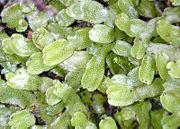
Nontracheophyte plants including the liverworts, hornworts and mosses undergo an alternation of generations; the gametophyte generation is the well-nigh common. The haploid gametophyte produces haploid gametes in multicellular gametangia. Female gametangia are called archegonium and produce eggs, while male structures called antheridium produce sperm. Water is required so that the sperm can swim to the archegonium, where the eggs are fertilized to class the diploid zygote. The zygote develops into a sporophyte that is dependent on the parent gametophyte. Mature sporophytes produce haploid spores by meiosis in sporangia. When a spore germinates, it grows into another gametophyte.
Vascular plants
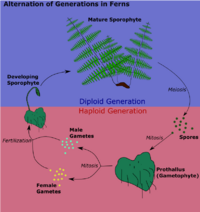
Diagram of alternation of generations in ferns.
Ferns and their allies, including clubmoss and horsetails, reproduce via an alteration of generations. The conspicuous found observed in the field is the diploid sporophyte. This found creates by meiosis single-celled haploid spores, which are shed and dispersed by the current of air (or in some cases, past floating on h2o). If conditions are correct, a spore will germinate and grow into a rather inconspicuous plant trunk called a prothallus.
The haploid prothallus does not resemble the sporophyte, and as such ferns and their allies have a heteromorphic alternation of generations. The prothallus is brusk-lived, just carries out sexual reproduction, producing the diploid zygote that and so grows out of the prothallus as the sporophyte.
Mammal reproduction and early on life wheel
In placental mammals, offspring are born equally juveniles: complete animals with the sex activity organs present although non-functional. After several months or years, the sex organs develop further to maturity and the animal becomes sexually mature. Most female person mammals are only fertile during certain periods and during those times, they are said to exist "in estrus." At this point, the animal is ready to mate. Individual male person and female mammals come across and bear out copulation.
Gestation, called pregnancy in humans, is the period of fourth dimension during which the fetus develops, dividing via mitosis inside the female. During this time, the fetus receives all of its nutrition and oxygenated blood from the female person, filtered through the placenta, which is attached to the fetus' abdomen via an umbilical cord. Once the fetus is sufficiently adult, chemic signals start the procedure of birth. The newborn, which is called an infant in humans, should typically begin respiration on its own shortly after birth.
In monotremes, the females lay eggs. They hold the eggs internally for several weeks, providing nutrients, and so lay them and cover them similar birds. Later on less than two weeks the young hatches and crawls into its female parent's pouch, much like marsupials, where it nurses for several weeks as information technology grows.
Marsupials reproduce in essentially the aforementioned manner, though their young are born at a far before stage of development than other mammals. Afterwards birth, marsupial joeys clamber into their mother's pouch and attach to a teat, where they receive nourishment and finish developing into self-sufficient animals.
Life history theory
In animal and human biology, life history theory is a method of agreement evolved behaviors and strategies to optimize reproductive success.
Life history theory is an belittling framework widely used in biological science, psychology, and evolutionary anthropology, which postulates that many of the physiological traits and behaviors of individuals may exist best understood in terms of the cardinal maturational and reproductive characteristics that define the life course.
Examples of these characteristics include:
- Historic period at weaning
- Age of sexual maturity or puberty
- Adult body size
- Age specific mortality schedules
- Age specific fecundity
- Fourth dimension to first sexual activity or mating
- Time to showtime reproduction
- Duration of gestation
- Litter size
- Interbirth interval
Variations in these characteristics reflect differing allocations of an individual'southward resources (i.due east., time, effort, and energy expenditure) to competing life functions, particularly growth, body maintenance, and reproduction. For any given individual, available resources in whatever detail environment are finite. Time, effort, and free energy used for one purpose diminishes the time try, and energy available for another. For example, resources spent growing to a larger torso size cannot be spent increasing the number of offspring. In general terms, the costs of reproduction may be paid in terms of energy being diverted away from body repair and maintenance and by reducing investment in immunological competence.
References
ISBN links support NWE through referral fees
- Dettmering, C., et al. 1998. The trimorphic life bicycle in foraminifera: Observations from cultures permit new evaluation. European Journal of Protistology 34:363-368.
- Graham, Fifty., J. Graham, and L. Wilcox. 2003. Plant Biological science. Upper Saddle River, NJ: Pearson Education.
- Raven, P. H., and Thou. B. Johnson. 1996. Biology. Dubuque, IA: Wn.C. Brownish Publishers.
- Roff, D. 1992. The Evolution of Life Histories: Theory and Analysis. New York: Chapman & Hall.
- Stearns, S. 1992. The Evolution of Life Histories. Oxford, England: Oxford University Printing.
- Taylor, T. N., et. al. 2005. Life history biology of early land plants: Understanding the gametophyte phase. Proceedings of the National Academy of Sciences 102:5892-5897.
Source: https://www.newworldencyclopedia.org/entry/Life_cycle
Posted by: nguyencreformen.blogspot.com

0 Response to "Which Of The Life Cycles Is (Are) Typical For Animals?"
Post a Comment